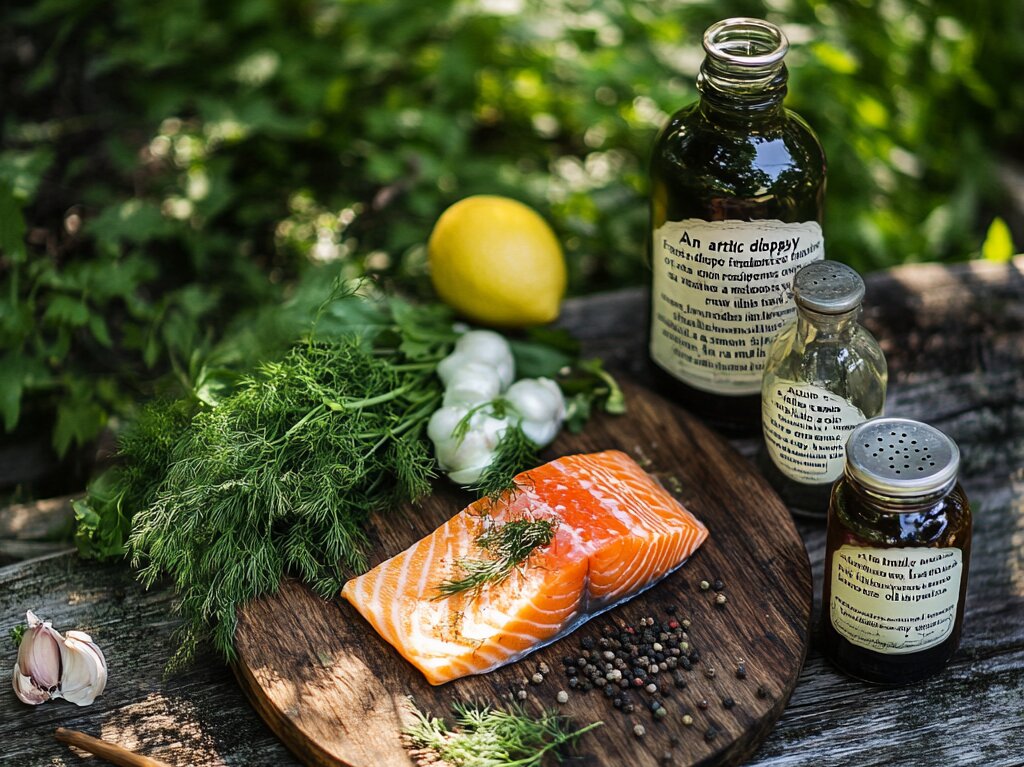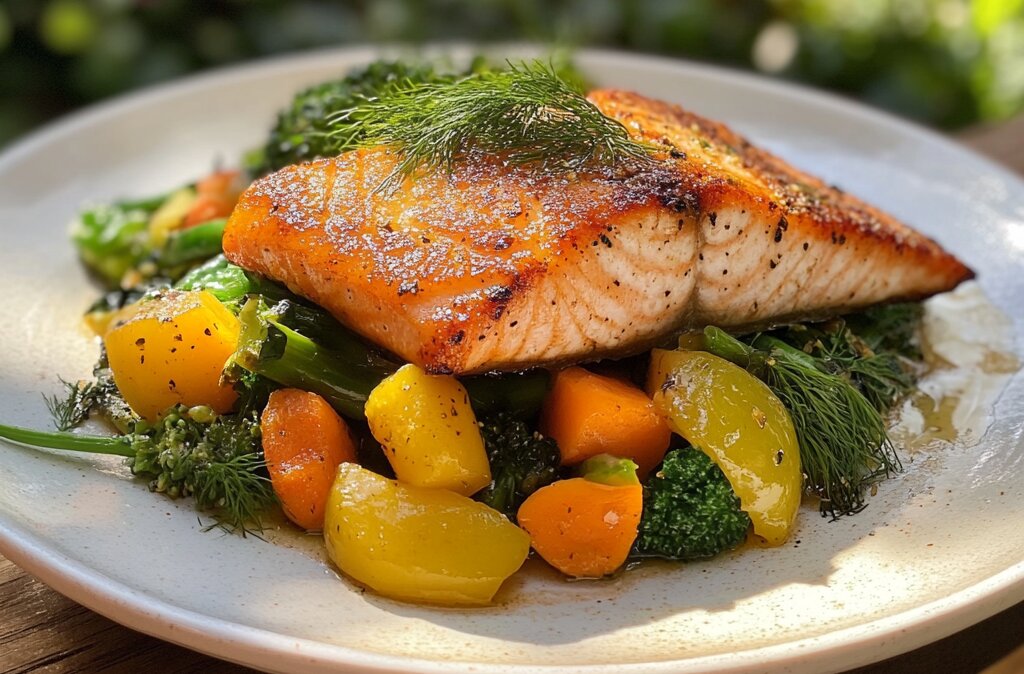Introduction to Perfectly Cooked Salmon
The Art of Cooking Salmon: Balancing Crispness and Moisture
Cooking crispy salmon without drying it out is an art that balances flavor, texture, and technique. Achieving that perfectly crispy skin while keeping the flesh tender and moist ensures your dish is both delicious and nutritious. By mastering the right methods, you can avoid common pitfalls like sogginess or dryness and create a restaurant-quality meal every time.
Why Achieving the Perfect Texture Matters
Texture plays a significant role in the dining experience. Salmon with crispy skin and tender flesh creates a perfect contrast, elevating both the flavor and visual appeal of your dish. On the contrary, overcooked, dry salmon can be tough and unappetizing.
Common Mistakes That Lead to Dry Salmon
To avoid a disappointing outcome, steer clear of:
- Overcooking: High heat for too long zaps moisture.
- Skipping seasoning: Insufficient salt can hinder crisping.
- Using too much oil: It can cause sogginess.
- Neglecting to dry the skin: Wet skin prevents crispness.
Benefits of Crispy yet Moist Salmon for Flavor and Health
A perfectly cooked piece of salmon isn’t just delicious; it’s also rich in nutrients like omega-3 fatty acids and proteins. Maintaining the right moisture helps preserve its health benefits and flavor, creating a meal that’s both nutritious and indulgent.

Understanding Salmon’s Natural Texture: Key Characteristics
Salmon’s natural texture varies depending on the cut and type. It’s known for its rich, buttery consistency. Understanding these nuances ensures you respect the fish’s integrity while cooking.
Importance of Fat Content in Different Salmon Varieties
Fat content plays a key role in determining how crispy and moist your salmon can get. Varieties like King Salmon or Atlantic Salmon are higher in fat, making them ideal for achieving a succulent texture. Leaner varieties, such as Sockeye, require more careful cooking.
Tools and Techniques Essential for Perfect Salmon Preparation
Investing in the right tools is half the battle. A non-stick pan or cast-iron skillet ensures even heating. A fish spatula helps flip without tearing the skin, and a thermometer helps monitor internal temperature for precision.
The Role of Skin in Salmon Texture: To Keep or Remove
The skin acts as a natural shield, protecting the flesh from overcooking. Leaving it on also allows you to achieve that desirable crispy texture. However, removing it is an option if you prefer a skinless experience.
How Cooking Methods Impact Salmon’s Crispness and Juiciness
Different cooking methods yield varied results:
- Pan-searing provides maximum crispness.
- Oven-baking offers even cooking with retained moisture.
- Air frying combines crispness and efficiency.
Each technique requires adjustments to maintain balance.
Overview of the Ideal Time and Temperature for Salmon
Timing and temperature are critical for success. Most salmon is cooked at medium-high heat for a short period:
- Pan-searing: 4–5 minutes skin-side down.
- Oven-baking: 375°F for 10–15 minutes.
- Internal temperature: Target 125°F–130°F for moist, medium salmon.
Preparation Steps for Crispy Salmon
Selecting the Right Salmon: Freshness and Quality Matter
The journey to perfectly crispy salmon begins with selecting high-quality fish. Opt for fillets that are:
- Firm to the touch.
- Free of a strong “fishy” odor.
- Bright and vibrant in color (pink or red, depending on the variety).
Freshness matters because it impacts both the texture and flavor. Wild-caught salmon often has superior taste and texture compared to farmed varieties. Look for trusted sources to ensure freshness.
Choosing the Right Cut: Fillet vs. Steak
When preparing salmon for crispiness, fillets are often preferable to steaks. Fillets provide:
- Uniform thickness for even cooking.
- A larger surface area for skin crisping.
Steaks, while flavorful, can be harder to crisp evenly due to their structure. They’re better suited for grilling.
How to Properly Debone Salmon for Better Cooking Results
Removing bones is essential for both ease of eating and optimal cooking. Use tweezers or a needle-nose plier to carefully remove the pin bones from the fillet. Feel along the flesh to locate them and pull them out in the direction of the grain.
This step not only makes the dish enjoyable but also helps the fillet cook evenly.
Preparing the Skin for Maximum Crispiness
Perfectly crispy skin begins with preparation:
- Scale the skin: Ensure all scales are removed to avoid toughness.
- Pat the skin completely dry: Any moisture will create steam and hinder crisping.
For added crispness, lightly score the skin with a sharp knife to prevent curling.
Drying Salmon Correctly: Why Moisture Control Is Critical
Dryness is the enemy of soggy skin. After patting your fillet dry, let it sit uncovered in the refrigerator for 30 minutes. This step allows the skin to dry out further, enhancing its ability to crisp when cooked.
Proper Seasoning Techniques: Salt, Pepper, and Beyond
Seasoning plays a key role in flavor and texture:
- Generously salt the skin side to draw out moisture, which helps with crisping.
- Add a light touch of pepper or other seasonings to the flesh side for flavor balance.
Avoid heavy seasoning blends on the skin, as they can burn during high-heat cooking.
The Best Oils for Crispy and Moist Salmon Cooking
Choosing the right oil is crucial. High-smoke-point oils like:
- Avocado oil
- Grapeseed oil
- Canola oil
These allow you to achieve the necessary high heat without burning. A small amount is all you need to coat the pan, as too much oil can make the skin soggy.
Adding Flavors Without Drying: Marinades, Rubs, and Glazes
Flavors can enhance salmon without sacrificing moisture. Consider:
- Marinades: Keep them light and avoid prolonged soaking (30 minutes max) to prevent breaking down the flesh.
- Dry rubs: Provide bold flavor without adding moisture.
- Glazes: Apply in the final minutes of cooking for a glossy finish without overcooking.
How Long to Marinate Salmon for Optimal Results
A good rule of thumb is 15–30 minutes for marinades. Acidic marinades (with lemon, vinegar, or yogurt) should be used sparingly, as they can “cook” the salmon prematurely, altering its texture.
Preheating Your Pan or Oven: Why It’s Non-Negotiable
Preheating is the foundation for crispiness. A hot surface ensures:
- Immediate searing of the skin.
- Even cooking throughout the fillet.
For pans, heat them on medium-high until a drop of water sizzles. For ovens, ensure they reach the desired temperature before adding the salmon.
Cooking Techniques for Crispy Salmon
Pan-Seared Salmon: The Classic Technique for Crispy Skin
Pan-searing is a time-tested method to achieve crispy salmon skin. Here’s how to do it perfectly:
- Heat the pan: Use a non-stick or cast-iron skillet. Preheat over medium-high heat and add a small amount of oil.
- Place the salmon skin-side down: Gently press the fillet with a spatula to prevent curling.
- Cook without flipping: Let the skin cook until it turns golden and crisp, about 4–5 minutes.
- Flip and finish: Turn the fillet and cook the flesh side for an additional 2–3 minutes.
Pro tip: Avoid overcrowding the pan, as this traps steam and reduces crispiness.
Oven-Baked Salmon: Retaining Moisture While Adding Crisp
Baking salmon in the oven ensures even cooking while retaining moisture. Follow these steps:
- Preheat the oven to 375°F.
- Place the salmon on a baking sheet lined with parchment paper.
- Brush the skin lightly with oil and sprinkle it with salt.
- Bake for 12–15 minutes, depending on the fillet’s thickness.
For extra crisp, finish under the broiler for 1–2 minutes.
Broiling for Extra Crisp: A High-Heat Technique
Broiling exposes the salmon to direct heat, which quickly crisps the skin. To broil salmon:
- Preheat your broiler and position the rack close to the heating element.
- Place the salmon on a baking tray, skin-side up.
- Broil for 5–7 minutes, keeping a close eye to prevent burning.
This method is ideal for thin fillets.
Air Fryer Salmon: A Modern Take on Crispness and Juiciness
The air fryer is an excellent tool for achieving crispy salmon with minimal effort. Here’s how:
- Preheat the air fryer to 400°F.
- Pat the fillet dry and season both sides.
- Place the salmon skin-side down in the basket.
- Cook for 7–9 minutes, depending on thickness.
The result? Golden, crispy skin with tender, flaky flesh.
Sous Vide with Pan Finish: Precision Cooking for Perfect Texture
Sous vide cooking offers unparalleled control over temperature and texture. The process:
- Vacuum-seal the salmon with seasoning and a touch of oil.
- Cook in a water bath set to 125°F for about 30 minutes.
- Remove and pat dry.
- Finish in a hot pan, skin-side down, for 1–2 minutes to crisp the skin.
This technique ensures a perfectly moist interior with a professional-quality crust.
Grilling Salmon: Achieving Smoky Crispness Without Drying
Grilling salmon infuses it with a smoky flavor while delivering crisp skin. Follow these tips:
- Use a well-oiled grill to prevent sticking.
- Cook skin-side down over medium heat for 4–6 minutes.
- Flip gently and cook for another 2–3 minutes.
For added flavor, grill on cedar planks to keep the fish moist while enhancing its smokiness.
Key Tips for Flipping Salmon Without Breaking the Skin
Flipping salmon without tearing the delicate skin requires patience and technique:
- Use a fish spatula: Its wide, thin design helps support the fillet.
- Flip only once: Frequent flipping can damage the skin.
- Ensure the skin is crisp before flipping; it should naturally release from the pan or grill.
Timing Is Everything: Avoiding Overcooking While Maximizing Crisp
Overcooked salmon is dry and tough. Stick to these guidelines:
- Cook thick fillets for 8–10 minutes total.
- Thin fillets take about 6–8 minutes.
- Always cook skin-side down first to maximize crispness.
Monitoring Internal Temperature for Perfect Results
A meat thermometer is your best ally in avoiding overcooked salmon. Insert the thermometer into the thickest part of the fillet:
- Medium-rare: 120°F
- Medium: 125°F–130°F
- Fully cooked: 135°F
Rest the salmon for a few minutes after cooking to allow the juices to redistribute.
Using Butter Basting for Enhanced Moisture and Flavor
Butter basting adds richness and helps retain moisture:
- Melt butter in the pan during the last few minutes of cooking.
- Add aromatics like garlic, thyme, or lemon slices.
- Spoon the butter over the salmon repeatedly to enhance flavor.
This step ensures your salmon stays succulent while delivering a restaurant-quality finish.
FAQs: Frequently Asked Questions
1. How do I prevent salmon from sticking to the pan?
Ensure the pan is preheated and well-oiled. Dry the salmon skin thoroughly before cooking and avoid moving it too soon.
2. What’s the best type of salmon for crisping?
Fatty varieties like King Salmon or Atlantic Salmon crisp well and remain moist.
3. Can I make salmon crispy without the skin?
Yes, by patting the flesh dry, seasoning well, and using high heat to form a crust.
4. How do I know when salmon is cooked through?
Check the internal temperature with a thermometer or look for opaque flesh that flakes easily.
5. Is it okay to eat the skin?
Yes! Salmon skin is safe and delicious when properly cooked.
6. What oils should I avoid for cooking salmon?
Avoid low-smoke-point oils like extra virgin olive oil, as they can burn at high heat.
7. Can I use frozen salmon for crispy skin?
Yes, but thaw it thoroughly and pat it dry before cooking.
8. How do I store leftovers?
Store cooked salmon in an airtight container in the fridge for up to 3 days.
9. Why does my salmon always turn out dry?
Overcooking or using lean varieties without adequate fat can lead to dryness.
10. What’s the easiest method for beginners?
Pan-searing is simple and delivers consistently crispy results with minimal effort.
Looking for more delicious ideas? Don’t stop here! Visit the rest of the articles on Recipes Faster to discover a world of quick, easy, and flavorful recipes.

